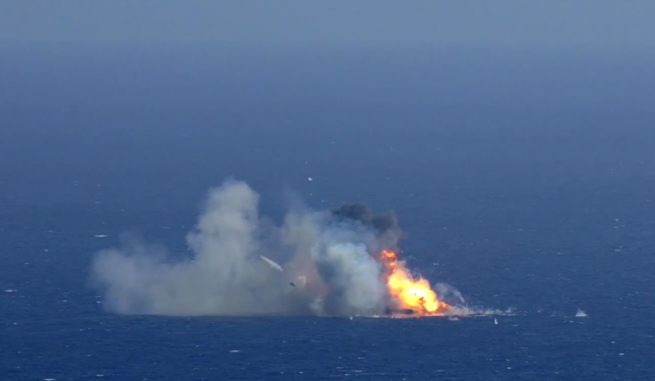
SpaceX CEO Elon Musk, is famous for his visionary and bold approach in inventing things that would shape the future.
But it seems he is running out of luck. He went a bit too far with his visionary approach, of landing a reusable booster rocket, on a football field sized barge in the middle of the ocean.
The unlucky entrepreneur and engineer, failed to land his Falcon 9 Rocket Booster, after a successful mission to deliver supplies which included an expresso machine to the International Space Station. The reusable booster landed successfully on a floating barge off the coast of Florida. However it tipped over after landing, due to excessive lateral velocity, according to Musk.

BYPASS THE CENSORS
Sign up to get unfiltered news delivered straight to your inbox.
You can unsubscribe any time. By subscribing you agree to our Terms of Use
Latest Video
The CEO of Tesla Motors, and chairman of SolarCity, is now planning not to push his luck too far. Instead of trying to land a Rocket on choppy seas , he’s going for the easier option of steady land.
Space Flight Insider reports:
The CRS-6 mission, as is usual for Commercial Resupply Services missions, had a single-second window for the launch to happen. Monday saw a scrub due to weather, but liftoff occurred successfully on Tuesday, the next opportunity for launch.
Just under three minutes after liftoff, the first stage separated from the rest of the vessel. After that, nitrogen thrusters flipped the vehicle into the proper direction for landing and then a boost-back burn brought it into the correct trajectory for the landing site. A re-entry burn combined with atmospheric drag worked to slow it down, after which its four hypersonic grid fins deployed to control the lift vector. Finally, a landing burn was performed, which was meant to slow the rocket down enough for it to touch down softly and safely. During this, the landing legs deployed, which are made of carbon fiber with aluminum honeycomb.
The booster did hit its football-field-sized target, the company’s autonomous spaceport drone ship with the unusual name “Just Read the Instructions” after a ship from author Iain M. Banks’ “Culture” book series. However, this was not quite the desired soft touchdown.
“Looks like Falcon landed fine, but excess lateral velocity caused it to tip over post landing,” tweeted SpaceX CEO and founder Elon Musk in the aftermath.
Looks like Falcon landed fine, but excess lateral velocity caused it to tip over post landing pic.twitter.com/eJWzN6KSJa
— Elon Musk (@elonmusk) April 14, 2015
Despite the sub-optimal landing and subsequent fireball, which can be viewed in the video below, the barge is nearly undamaged, according to Musk. “Droneship is fine. No hull breach and repairs are minor. Impact overpressure is closer to a fast fire than an explosion,” he tweeted on Wednesday.
The attempt to land the Falcon 9 booster rocket’s first stage in order to recover it and use it again is part of a goal to make space travel less expensive and more accessible. Currently, rockets are used once and discarded, made to burn up when they re-enter Earth’s atmosphere. Stabilizing one for a safe re-entry is a task that SpaceX describes as “trying to balance a rubber broomstick on your hand in the middle of a wind storm.”
“If one can figure out how to effectively reuse rockets just like airplanes, the cost of access to space will be reduced by as much as a factor of a hundred,” Musk has said. “A fully reusable vehicle has never been done before. That really is the fundamental breakthrough needed to revolutionize access to space.”
The company tested their rocket landing concepts using a 10-story-tall Vertical Takeoff Vertical Landing (VTVL) vehicle they called the Grasshopper. It consisted of “a Falcon 9 first stage, a single Merlin 1D engine, four steel landing legs with hydraulic dampers, and a steel support structure,” according to SpaceX. The vehicle did see eight flight tests with successful landings in 2013, with a top altitude of 744 meters up.
After Grasshopper, SpaceX tested their F9R development vehicle – basically a Falcon 9 first stage with landing legs – in McGregor, Texas, with several successful attempts and a top test altitude of 1000 meters.
Their first real-mission attempt to land a Falcon 9 first stage was CRS-5 in January of this year. The experiment ended in a “Full RUD (rapid unscheduled disassembly) event,” as Musk described it at the time. The rocket had run out of hydraulic fluid, which was necessary to steer the grid fins that kept the stage pointed upright.
Another attempt was planned for February, with the launch of the DSCOVR orbiter, but due to stormy weather and dangerous waves, the landing attempt was scrubbed and the booster was directed for a “soft landing” in the water instead. The rocket was not expected to survive in that case.
The next opportunity for the company to try to stick the landing will be the CRS-7 mission, which is currently targeted for June of this year. According to Defense News, Gwynne Shotwell, SpaceX president and COO, said on Wednesday that they hope the next landing will take place on land, not at sea, for the added stability of firm ground.
Dramatic moment SpaceX rocket tipped over and exploded



